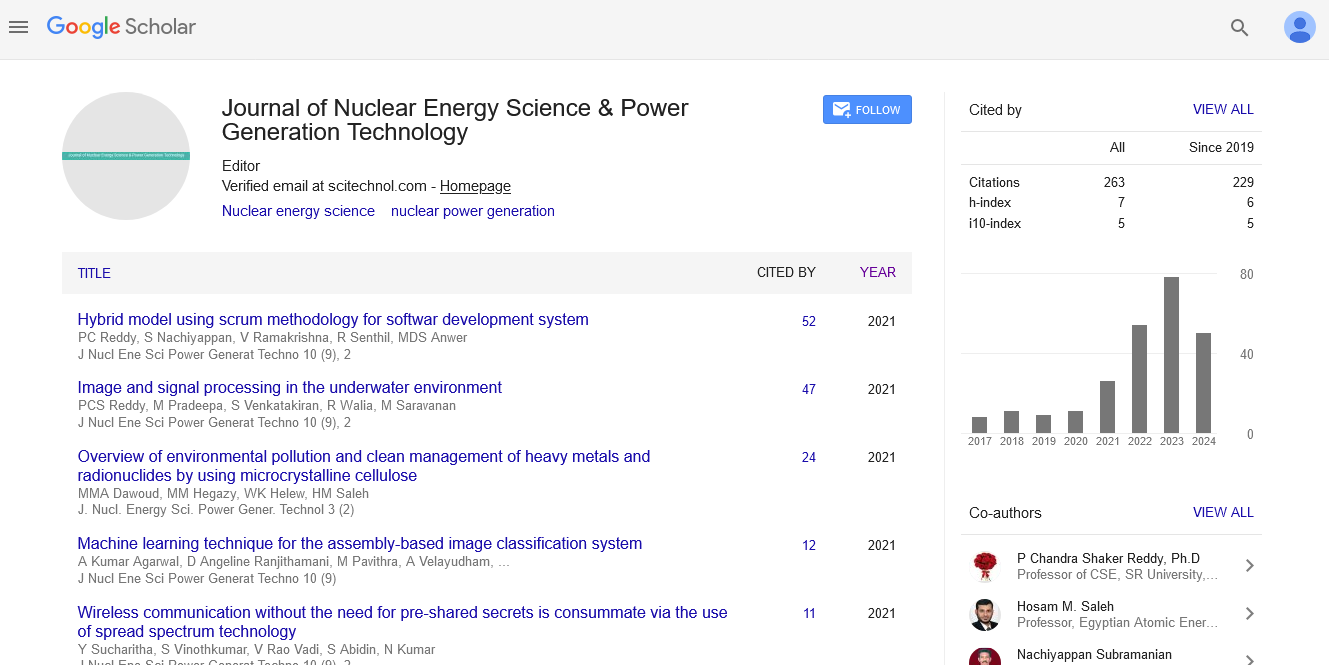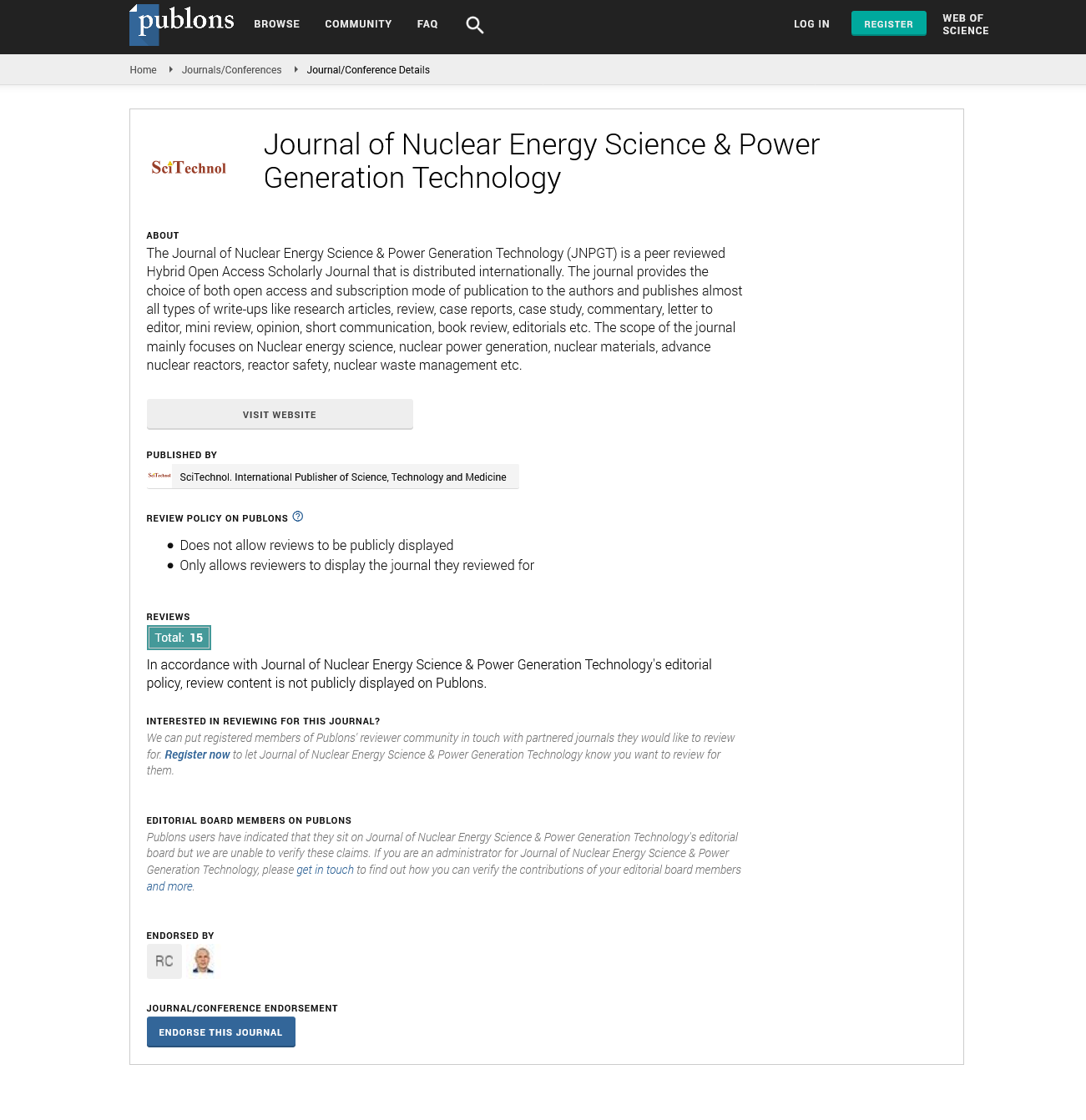Opinion Article, J Nucl Ene Sci Power Generat Technol Vol: 13 Issue: 2
Complexities of Gas-Based Power Generation and its Technology, Environmental Implications
Yuie Sie*
1Department of Energy and Power Engineering, Tsinghua University, Beijing, China
*Corresponding Author: Yuie Sie,
Department of Energy and Power Engineering,
Tsinghua University, Beijing, China
E-mail: yuie_sie123@gmail.com
Received date: 13 February, 2024, Manuscript No. JNPGT-24-133565;
Editor assigned date: 15 February, 2024, PreQC No. JNPGT-24-133565 (PQ);
Reviewed date: 29 February, 2024, QC No. JNPGT-24-133565;
Revised date: 07 March, 2024, Manuscript No. JNPGT-24-133565 (R);
Published date: 15 March, 2024, DOI: 10.4172/2325-9809.1000383.
Citation: Sie Y (2024) Complexities of Gas-Based Power Generation and its Technology, Environmental Implications. J Nucl Ene Sci Power Generat Technol 13:2.
Description
Gas-based power generation has emerged as a cornerstone of the global energy landscape, providing a cleaner and more efficient alternative to traditional fossil fuels. Leveraging natural gas, a versatile and abundant resource, this method of electricity production has gained prominence for its lower emissions, flexibility, and reliability the intricacies of gas-based power generation, its technology, environmental implications, and its role in shaping the future of energy. Gas-based power generation utilizes natural gas, a hydrocarbon fuel composed primarily of methane, as its primary energy source. The process typically involves the combustion of natural gas in gas turbines or combined cycle power plants to generate electricity.
Gas turbines, also known as combustion turbines, convert the chemical energy of natural gas into mechanical energy through combustion, driving a generator to produce electricity. Combined cycle power plants integrate gas turbines with steam turbines, allowing for higher efficiency by harnessing waste heat from the gas turbine exhaust to generate additional electricity. Gas turbines are the heart of gas-based power generation systems. These turbines consist of compressor sections, combustion chambers, and turbine sections. Compressor sections draw in air and compress it before mixing it with natural gas in combustion chambers. The ignited mixture expands in the turbine section, driving the turbine blades and generating mechanical energy to produce electricity.
Combined cycle power plants enhance efficiency by utilizing both gas and steam turbines. In addition to gas turbines, these plants incorporate Heat Recovery Steam Generators (HRSG) to capture waste heat from the gas turbine exhaust. The heat is used to produce steam, which then drives a steam turbine to generate additional electricity. This configuration significantly increases the overall efficiency of the power plant, making combined cycle systems a preferred choice for large-scale electricity generation. Gas-based power generation provides several environmental benefits compared to traditional coal-fired power plants. Natural gas combustion produces fewer greenhouse gas emissions, including carbon dioxide (CO2), sulfur dioxide (SO2), and nitrogen oxides (NOx), resulting in lower air pollution and moderating the impacts of climate change. Additionally, gas-based power plants emit minimal particulate matter and pollutants, contributing to improved air quality and public health.
Moreover, the flexibility of gas-based power generation enables rapid response to fluctuations in electricity demand, complementing intermittent renewable energy sources such as wind and solar power. This flexibility enhances grid stability and reliability, facilitating the integration of renewable energy into the power grid while ensuring a consistent power supply. Gas-based power generation plays a significant role in the ongoing energy transition towards a more sustainable and resilient energy system. As countries strive to reduce their reliance on coal and transition towards cleaner energy sources, natural gas serves as a bridging fuel that provides a lower-carbon alternative while facilitating the integration of renewables. Furthermore, advancements in gas turbine technology, such as the development of high-efficiency turbines and the use of hydrogen blends, further reducing emissions and enhancing the sustainability of gas-based power generation.
Conclusion
Gas-based power generation represents a pivotal component of the global energy mix, providing a cleaner, more efficient, and flexible alternative to traditional fossil fuels. With its lower emissions, high efficiency, and role in supporting renewable energy integration, gasbased power generation is poised to play an important role in driving the transition towards a sustainable energy future. Embracing technological innovations and adopting policies that promote the responsible use of natural gas can unlock the full potential of gasbased power generation in meeting the growing demand for reliable and environmentally friendly electricity. Additionally, initiatives to capture and store CO2 emissions from gas-fired power plants, known as Carbon Capture And Storage (CCS), provide a pathway to further moderate environmental impacts and achieve carbon neutrality in the power sector.
 Spanish
Spanish  Chinese
Chinese  Russian
Russian  German
German  French
French  Japanese
Japanese  Portuguese
Portuguese  Hindi
Hindi 

